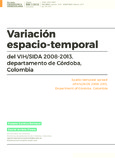Mostrar el registro sencillo del ítem
Variación espacio-temporal del VIH/SIDA 2008-2013, departamento de Córdoba, Colombia
| dc.rights.license | http://creativecommons.org/licenses/by-nc-sa/3.0/ve/ | es_VE |
| dc.contributor.author | Garnica Berrocal, Rosana | |
| dc.contributor.author | Arrieta Rivera, Daniel | |
| dc.date.accessioned | 2018-04-26T20:38:24Z | |
| dc.date.available | 2018-04-26T20:38:24Z | |
| dc.date.issued | 2018 | |
| dc.identifier.issn | 1012-1617 | |
| dc.identifier.uri | http://www.saber.ula.ve/handle/123456789/44697 | |
| dc.description.abstract | Este artículo determina la variación espacio-temporal del VIH/Sida en el departamento de Córdoba (Colombia), durante el periodo 2008 - primer semestre de 2013, para establecer el patrón espacial de la enfermedad mediante la aplicación del coeficiente I de Morán, partiendo del número de casos en cada uno de los 30 municipios, según el registro del Sistema de Vigilancia Epidemiológica del Instituto Nacional de Salud (Sivigila). Se elaboró cartografía multitemporal en el software ArcGis 9.3. El patrón de concentración resultó en municipalidades con mayor oferta de bienes y dinamismo poblacional, en donde los comportamientos humanos pueden ser riesgosos para la salud; y el de dispersión en localidades con predominio rural, rezago económico y baja productividad. Se realizaron entrevistas semi-estructuradas a médicos generales y psicólogos, quienes trabajan en Profamilia (Montería) y la Fundación Oportunidad y Vida, para conocer el comportamiento del virus y la asimilación en el paciente. | es_VE |
| dc.language.iso | es | es_VE |
| dc.publisher | SaberULA | es_VE |
| dc.rights | info:eu-repo/semantics/openAccess | es_VE |
| dc.subject | Geografía de la salud | es_VE |
| dc.subject | variación espacio-temporal | es_VE |
| dc.subject | autocorrelación espacial | es_VE |
| dc.subject | VIH/SIDA | es_VE |
| dc.title | Variación espacio-temporal del VIH/SIDA 2008-2013, departamento de Córdoba, Colombia | es_VE |
| dc.title.alternative | Spatio-temporal spread of HIV/AIDS 2008-2013, Department of Córdoba, Colombia | es_VE |
| dc.type | info:eu-repo/semantics/article | es_VE |
| dc.description.abstract1 | This article determines the spatiotemporal spread of HIV/AIDS in the municipalities of Córdoba (Colombia) during the period 2008 - first half of 2013, in order to establish the spatial pattern of disease by applying the Ι Moran coefficient, based on the number of cases in each of the 30 municipalities, according to the registration Epidemiological Surveillance System of the National Institute of Health (SIVIGILA). Multi-temporal mapping was developed through the ArcGis 9.3 software. The pattern of concentration resulted in municipalities with greater supply of goods and population dynamism, where human behaviors can be risky for health; and that of dispersion in localities with rural predominance, economic backwardness and low productivity. Semi-structured interviews were conducted with general practitioners and psychologists, who work in Profamilia (Monteria) and the Opportunity and Life Foundation, to know the behavior of the virus and assimilation in the patient. | es_VE |
| dc.description.colacion | 112-129 | es_VE |
| dc.description.email | rgarnica@correo.unicordoba.edu.co | es_VE |
| dc.description.email | danielantorivera@hotmail.com | es_VE |
| dc.description.frecuencia | Semestral | |
| dc.identifier.depositolegal | pp 195902ME658 | |
| dc.identifier.edepositolegal | ppi 2012ME4104 | |
| dc.identifier.eissn | 2244-8853 | |
| dc.publisher.pais | Venezuela | es_VE |
| dc.subject.facultad | Facultad de Ciencias Forestales y Ambientales | es_VE |
| dc.subject.institucion | Universidad de Los Andes | es_VE |
| dc.subject.institutoinvestigacion | Instituto de Geografía y Conservación de los Recursos Naturales (IGCRN) | |
| dc.subject.keywords | Health geography | es_VE |
| dc.subject.keywords | spatio-temporal variation | es_VE |
| dc.subject.keywords | spatial autocorrelation | es_VE |
| dc.subject.keywords | HIV/AIDS | es_VE |
| dc.subject.publicacionelectronica | Revista Geográfica Venezolana | |
| dc.subject.seccion | Revista Geográfica Venezolana: Artículos | es_VE |
| dc.subject.thematiccategory | Geografía | es_VE |
| dc.subject.tipo | Revistas | es_VE |
| dc.type.media | Texto | es_VE |
Ficheros en el ítem
Este ítem aparece en la(s) siguiente(s) colección(ones)
-
Revista Geográfica Venezolana - 059(1)
Enero - Junio 2018


